Scientists have recently announced the discovery of 11 caves and rock shelters of significant archaeological value belonging to the Hoa Binh culture, along with Con Hen 1 and Con Hen 2 from the Dong Son culture, which are notable for their natural landscapes and connections to millions of years of geological formation, located in the Tam Chuc scenic area, Kim Bang (Ha Nam).
11 Stunning Caves
On November 2, at the 58th National Archaeology Conference, the purpose was to report, discuss, and publish “New Research Discoveries in Vietnamese Archaeology in 2023.”
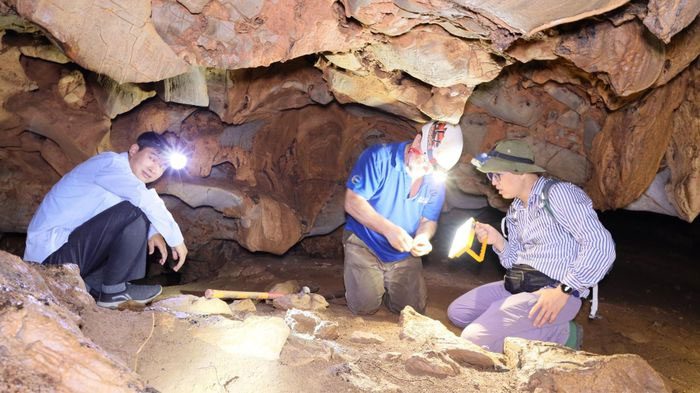
Experts surveying the Thien Dinh cave in the Tam Chuc complex.
Notably, at the conference, scientists reported that from 2021 to 2022, the Ha Nam Provincial Museum collaborated with the Institute of Archaeology to conduct investigations, surveys, and comprehensive assessments of archaeological sites in the area. This work resulted in the discovery of over 20 archaeological sites and remains with potential for future excavation and study.
In particular, in the central region of the Tam Chuc scenic area, researchers discovered 11 caves and rock shelters of significant archaeological value from the Hoa Binh culture, along with Con Hen 1 and Con Hen 2 from the Dong Son culture. These caves, rock shelters, and karst wells have notable natural landscape value and relate to the geological formations spanning millions of years.
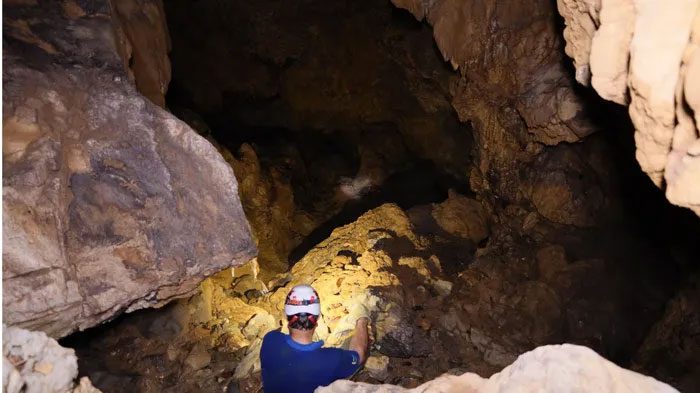
Surveying at Co Sao Mountain Cave in the Tam Chuc complex.
These discoveries play an important role in the excavation and study of archaeology, helping to delve deeper into the mysteries of the cultural history of the Tam Chuc – Kim Bang (Ha Nam) region throughout the nation’s historical development.
Additionally, in March 2023, the Institute of Archaeology, the Ha Nam Museum, and Tam Chuc Tourism Service Company coordinated to conduct a survey at Thung Na, located in Group 8, Ba Sao Town, Kim Bang District. At Thung Na 1 Cave and Thung Na 3 Rock Shelter, they discovered prehistoric remains and material culture artifacts from the prehistoric period. These findings include animal fossils and artifacts such as brown-red ceramic fragments from the Dong Son culture.

The survey team examining a stele during the excavation at Van Mong Pagoda.
Moreover, the survey team also discovered a prehistoric site on the summit of Lo Voi Mountain near the Tam Quan area outside Tam Chuc Pagoda. This site is located at a latitude of 20°31’52.3″ North and a longitude of 105°48’04.7″ East, approximately 50 meters above sea level. The survey results on the mountain summit revealed many marine mollusk shells along with freshwater snail shells.
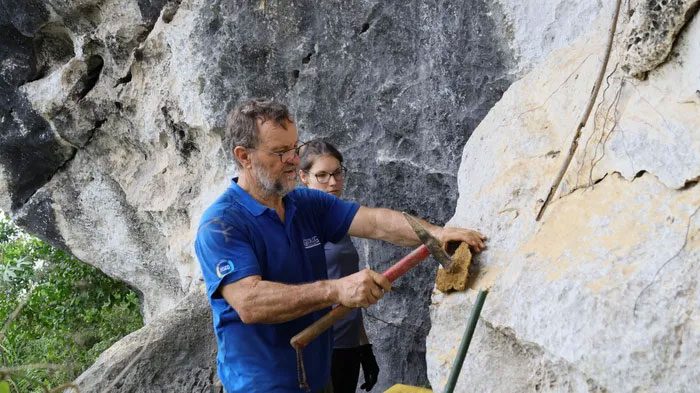
The Paris University team collecting stone samples at the Mo Set quarry in the Tam Chuc complex.
Notably, at the mountain summit, which has an area of approximately 60 square meters, they discovered fragments of ceramic mouths and body pieces alongside marine and freshwater mollusks. The survey results indicate that this area has many archaeological sites dating from the late Pleistocene to the late Holocene.
This reveals that Kim Bang was once a very favorable area that ancient inhabitants utilized and inhabited through various historical periods.
Discovery of Human Remains Dating Back Approximately 10,000 Years
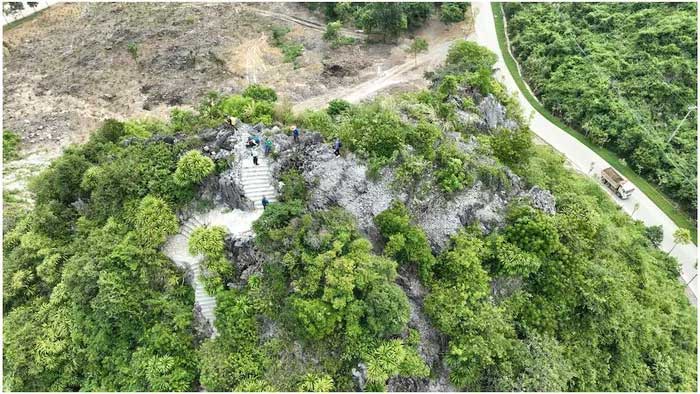
Dốc Tù Mountain in the Tam Chuc complex.
During the first excavation at pit H1, located in the central region of the Tam Chuc scenic area, Ba Sao Town (Kim Bang), scientists discovered three burial sites of children and adults. These are types of reburial and double burial, with the bodies placed in a curled position. This marks the first discovery of human remains dating back approximately 10,000 years.
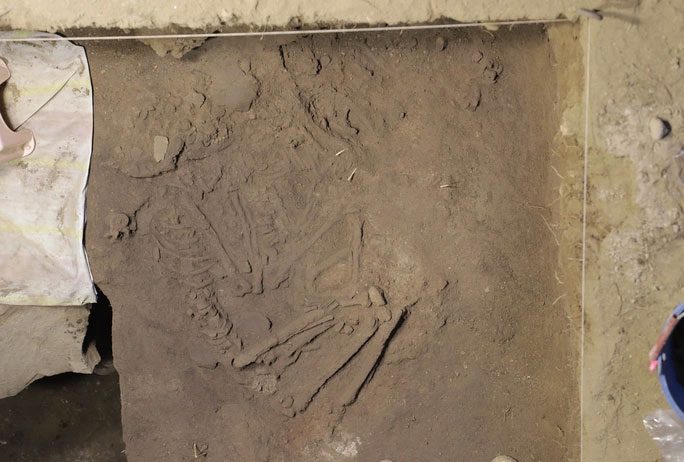
Human bones excavated at cave pit team 4 in the core area of the Tam Chuc scenic complex.
Additionally, researchers also discovered animal remains, including mollusk shells and animal teeth, which were found in significant quantities through different excavation layers. Most of the animal remains found in the excavation pit belonged to small mammals, which were an important food source for ancient inhabitants in the past. Furthermore, the types of stone tools found in the excavation pit were not large, but their characteristics and techniques indicate that the stone artifacts collection here belongs to the Hoa Binh culture.
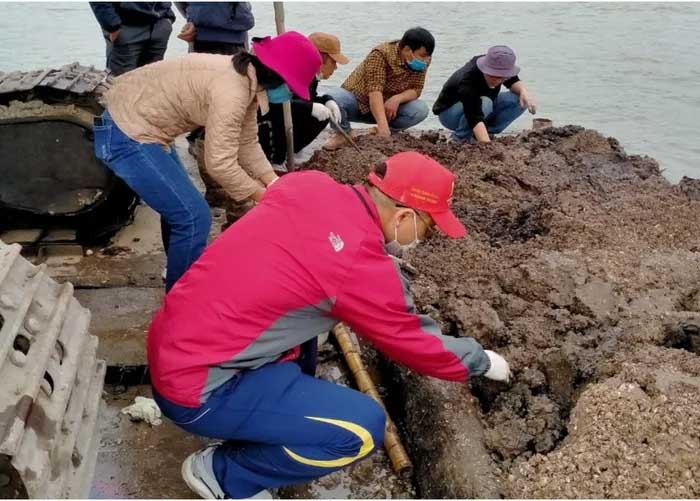
Survey at Hen 1 quarry, Tam Chuc lake bed.
Moreover, at other archaeological sites such as the tomb tower in the Lanh Giang Temple complex, architectural ruins at Van Mong Pagoda, exploratory digging at Chuong Cave, the Viên Quang Chân Nhân area, the Lạt Sơn base, Dang Xa Pagoda, Dong Vu Pagoda, and Ngo Pagoda, many valuable relics were also discovered.
| The Tam Chuc Scenic Complex has been classified as a National Heritage site by decision number 391/QD dated February 24, 2023. This is an important recognition of the historical and cultural value of the region. |


















































